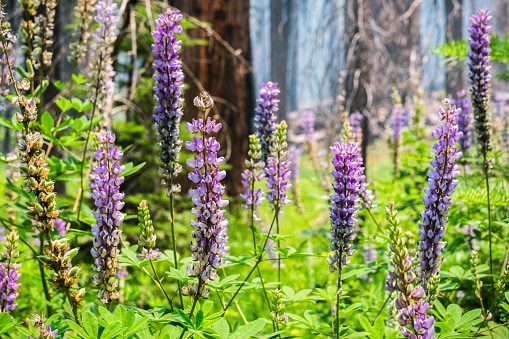Silver Lupine, or Lupinus Albifrons, is an evergreen perennial flower with beautiful palmate leaves that are silky and gray. It produces long clusters of blue to magenta pea-shaped flowers that bloom from spring. It is a showy and fragrant flower that is low maintenance and attracts pollinators. It can reach heights of up to five feet and does best in sandy or rocky soils with a neutral to slightly alkaline pH. It thrives in sunny, warm conditions and is hardy in zones 5-8.
Silver Lupine is native to the Mediterranean region, where it has been cherished for centuries. It was first mentioned in ancient writings and was heralded for its medicinal qualities. Silver Lupine has also been used in traditional ceremonies and festivals, as well as featured in sculpture and other works of art.
Plant Type
Silver Lupine is a perennial wildflower that can grow and bloom for multiple years. As a wildflower, it is adapted to thrive in natural environments and can tolerate a wide range of conditions. Its hardy and resilient nature makes it a popular choice for gardeners looking to incorporate native plants into their landscapes. Perennial plants, such as Silver Lupine, are a great investment for gardeners, as they can save time and money by not having to replant every year. Additionally, they can provide habitat and food for pollinators and other wildlife.
Mature Size
The plant can grow up to 3 feet tall and 2 feet wide, making it a substantial presence in a garden or landscape. Its tall, erect stems are typically covered in a dense cluster of blue, white, or pink flowers, which can attract pollinators such as bees and butterflies. In addition to its height, Silver Lupine’s spread can also make it a great choice for filling in gaps in garden beds or providing ground cover. However, it’s important to keep in mind its mature size when planning where to plant it, as it may overshadow smaller plants or become too crowded in narrow spaces.
Buy this beautiful “Bloom into You” planner on Amazon>>
Sun Exposure
It prefers full sun exposure, which is defined as at least six hours of direct sunlight per day. However, it can also tolerate some shade, particularly in hot climates, where partial shade may provide relief from the intense heat of the sun. When planted in partial shade, Silver Lupine may not grow as tall or produce as many flowers, but it will still thrive and add beauty to the landscape. As with many plants, it’s important to consider the specific conditions of the planting site when deciding on the best amount of sun exposure for Silver Lupine. For example, if planted in a location with very hot afternoon sun, some shade may be beneficial to prevent wilting and stress on the plant.
Soil Type
Silver Lupine prefers a well-draining soil that allows excess water to drain away from the plant’s roots. This type of soil is important to prevent root rot, which can occur when roots are constantly in waterlogged soil. The ideal pH range for Silver Lupine is between 6.0 to 7.5, which is slightly acidic to neutral. This range allows the plant to absorb the necessary nutrients from the soil and ensures optimal growth and health. Soil amendments such as compost or aged manure can be added to improve soil structure and fertility, but it’s important to avoid adding too much nitrogen, as this can cause excessive foliage growth at the expense of flower production.
Fertilizer
Fertilizer can be beneficial for Silver Lupine, but it’s important to use it sparingly and at the right time. Silver Lupine doesn’t need a lot of fertilizer, as excessive amounts can actually harm the plant. It’s recommended to use a slow-release, balanced fertilizer that provides equal amounts of nitrogen, phosphorus, and potassium. The best time to apply fertilizer is during early spring, just as the plant begins to emerge from dormancy. Be sure to follow the instructions on the fertilizer package and avoid getting the fertilizer on the leaves or stem of the plant, as this can cause damage. Over-fertilizing can lead to excessive foliage growth at the expense of flower production, so it’s important to use a light hand when applying fertilizer to Silver Lupine.
How to Plant Silver Lupine
When planting Silver Lupine, start by selecting a location with full sun exposure and moist, well-draining soil. To provide extra nutrition to the plant, mix organic material into the soil. Make sure the soil is not too heavy as this can lead to root rot. Water the plant deeply once a week if rainfall is not sufficient.
To maintain healthy growth of Silver Lupine, place mulch around the base of the plant to help keep the soil moist and cool during hot summers. Regular pruning and deadheading will also help the plant stay strong and promote flower growth. It’s important to note that Silver Lupine is a drought-tolerant plant that can thrive in sandy soil, making it a good choice for areas with low rainfall.
Propagation
Propagation is a relatively easy process, but can be time-consuming. It is done by taking cuttings from the stems near the soil and allowing them to root in sandy soil or compost. Once the plant has established roots, it can be transplanted into a larger pot or directly into the soil.
Common Pests and Diseases
Common pests and diseases that may affect this plant include aphids, butterflies, thrips, and viruses. To prevent these from occurring, it is best to provide the Silver Lupine with proper care and plenty of sun. If signs of pests appear, it is best to treat them with an insecticidal soap.
Meaning and Symbolism
Silver lupine is commonly associated with imagination, creativity, and renewal. It is often given as a gift to encourage someone to pursue their dreams and embrace their inner childlike wonder. In Native American cultures, lupines are sometimes seen as symbols of protection and strength. The specific meaning of the silver lupine can vary depending on the culture and context in which it is given or used.
Religious Significance
In some Native American tribes consider the lupine plant as a sacred and medicinal plant, and it has been used in traditional healing ceremonies.
In Christianity, white flowers like the silver lupine are often associated with purity and the Virgin Mary, and may be used in religious ceremonies or as symbols of the divine.
Three Frequent Asked Questions
Q: Can Silver Lupine be grown indoors?
A: Silver Lupine prefers to be grown outdoors, but it can be grown in a pot on a sunny windowsill.
Q: How do I care for Silver Lupine in the winter?
A: Silver Lupine is hardy in temperatures below 0°C, but it is not recommended to leave it outside during the winter. It is best to bring the plant indoors and allow it to rest in a bright spot that gets some sun.
Q: What is the best way to prune Silver Lupine?
A: The best way to prune Silver Lupine is to remove any dead, diseased or damaged leaves and stems. Pruning can be done in the spring or summer, and it is beneficial for the plant, as it helps to promote new growth and encourage more flowers.
Fact Sheet
| Common Name | Silver Lupine |
|---|---|
| Scientific Name | Lupinus albifrons |
| Family | Fabaceae |
| Plant Type | Herbaceous perennial |
| Mature Size | 2-3 feet tall and wide |
| Sun Exposure | Full sun to partial shade |
| Soil Type | Well-draining, sandy soil |
| Soil pH | Acidic to neutral (5.5-7.5) |
| Bloom Time | Late winter to early summer |
| Flower Color | Shades of blue and purple |
| Hardiness Zones | 7-10 |
| Native Area | California and Baja California, Mexico |
Note: This plant is drought tolerant and can attract pollinators such as bees and butterflies to your garden. It is also deer resistant, making it a good choice for areas with deer populations.
What we love from Amazon this week
Buy these wonderful flowers directly from Amazon:
















